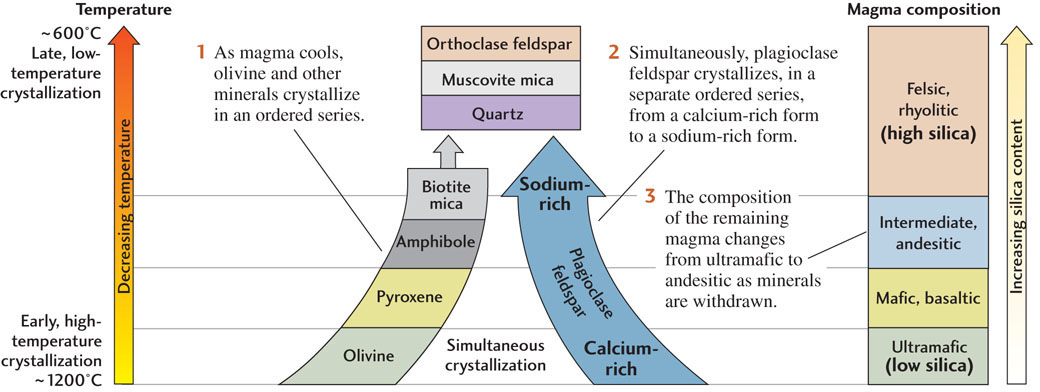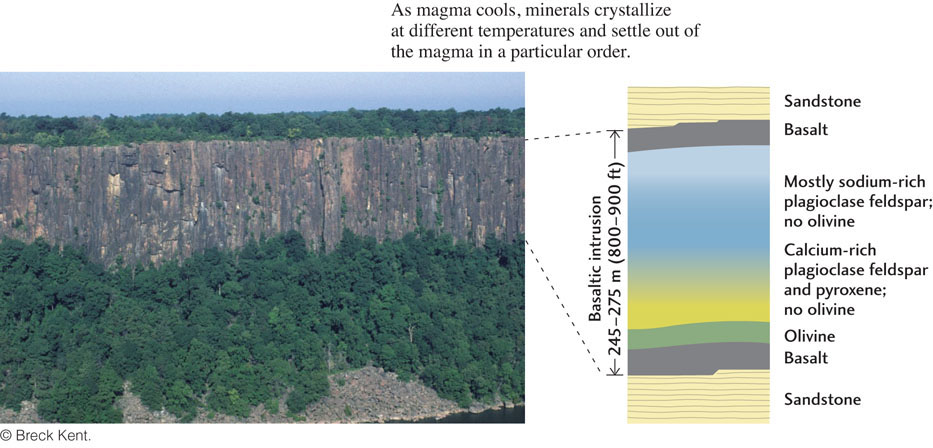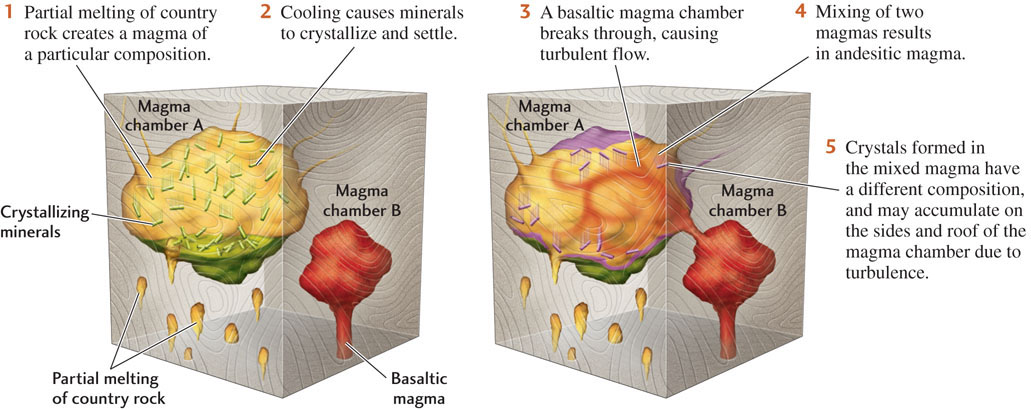Magmatic Differentiation
The processes we’ve discussed so far account for the melting of rocks to form magmas. But what accounts for the variety of igneous rocks? Are magmas of different chemical compositions made by the melting of different kinds of rock? Or do igneous processes produce a variety of rocks from an originally uniform parent material?
Again, the answers to these questions came from laboratory experiments. Geologists mixed chemical elements in proportions that simulated the compositions of natural igneous rocks, then melted those mixtures. As the melts cooled and solidified, the geologists observed and recorded the temperatures at which crystals formed, as well as the chemical compositions of those crystals. This research gave rise to the theory of magmatic differentiation, a process by which rocks of varying composition can arise from a uniform parent magma. Magmatic differentiation occurs because different minerals crystallize at different temperatures.
In a kind of mirror image of partial melting, the last minerals to melt are the first minerals to crystallize from a cooling magma. This initial crystallization withdraws chemical elements from the melt, changing the magma’s composition. Continued cooling crystallizes the minerals that melted at the next lower temperature range. Again, the magma’s chemical composition changes as various elements are withdrawn. Finally, as the magma solidifies completely, the last minerals to crystallize are the ones that melted first. Thus, the same parent magma, because of its changing chemical composition throughout the crystallization process, can give rise to different types of igneous rocks.
Fractional Crystallization: Laboratory and Field Observations
Fractional crystallization is the process by which the crystals formed in a cooling magma are segregated from the remaining liquid rock. This segregation happens in several ways, following a sequence commonly described as Bowen’s reaction series (Figure 4.6). In the simplest scenario, crystals formed in a magma chamber settle to the chamber’s floor and are thus removed from further reaction with the remaining liquid. Thus, crystals that form early are segregated from the remaining magma, which continues to crystallize as it cools.

The effects of fractional crystallization can be seen in the Palisades, a line of imposing cliffs that faces the city of New York on the west bank of the Hudson River (Figure 4.7). This igneous formation is about 80 km long and, in places, more than 300 m high. It formed as a magma of basaltic composition intruded into nearly horizontal layers of sedimentary rock. It contains abundant olivine near the bottom, pyroxene and calcium-rich plagioclase feldspar in the middle, and mostly sodium-rich plagioclase feldspar near the top. This variation in mineral composition from bottom to top made the Palisades a perfect site for testing the theory of fractional crystallization.

100
Geologists melted rocks with about the same mineral compositions as those found in the Palisades intrusion and determined that the initial temperature of the magma from which it formed had to have been about 1200°C. The parts of the magma within a few meters of the relatively cold country rock above and below it cooled quickly. This quick cooling formed a fine-grained basalt and preserved the chemical composition of the original magma. The hot interior cooled more slowly, as evidenced by the slightly larger crystals found in the intrusion’s interior.
The theory of fractional crystallization leads us to expect that the first mineral to crystallize from the slowly cooling interior of the Palisades intrusion would have been olivine, as this heavy mineral would sink through the melt to the bottom of the intrusion. It can be found today as a coarse-grained, olivine-rich layer just above the chilled, fine-grained basaltic layer along the bottom zone of contact with the underlying sedimentary rock. Plagioclase feldspar would have started to crystallize at about the same time; it has a lower density than olivine, however, and so would have settled to the bottom more slowly (see Practicing Geology). Continued cooling would have produced pyroxene crystals, which would have reached the bottom next, followed almost immediately by calcium-rich plagioclase feldspar. The abundance of plagioclase feldspar in the upper parts of the intrusion is evidence that the magma continued to change in composition until successive layers of settled crystals were topped off by a layer of mostly sodium-rich plagioclase feldspar. In addition to crystallizing at a lower temperature, sodium-rich plagioclase feldspar is less dense than either olivine or pyroxene, so it would have settled out last.
101
Being able to explain the layering of the Palisades intrusion as the result of fractional crystallization was an early success in understanding magmatic differentiation. It firmly tied field observations to laboratory results and was solidly based on chemical knowledge. We now know that this intrusion actually has a more complex history that includes several injections of magma and a more complicated process of olivine settling. Nevertheless, the Palisades intrusion remains a valid example of fractional crystallization.
Granite from Basalt: Complexities of Magmatic Differentiation
Studies of volcanic lavas have shown that basaltic magmas are common—far more common than the rhyolitic magmas that correspond in composition to granites. How, then, could granites have become so abundant in Earth’s crust? The answer is that the process of magmatic differentiation is much more complex than geologists first thought.
The original theory of magmatic differentiation suggested that a basaltic magma would gradually cool and differentiate into a more felsic magma by fractional crystallization. The early stages of this differentiation would produce an andesitic magma, which might erupt to form andesitic lavas or solidify by slow crystallization to form dioritic intrusions. Intermediate stages would result in magmas of granodioritic composition. If the process were carried far enough, its late stages would form rhyolitic lavas and granitic intrusions. One line of research has shown, however, that so much time would be needed for small crystals of olivine to settle through a dense, viscous magma that they might never reach the bottom of a magma chamber. Other researchers have demonstrated that many layered intrusions—similar to but much larger than the Palisades intrusion—do not show the simple progression of layers predicted by the original theory.
The greatest sticking point in the original theory, however, was the source of granite. The great volume of granite found on Earth could not have formed from basaltic magmas by magmatic differentiation, because large quantities of liquid volume are lost by crystallization during successive stages of differentiation. To produce a given amount of granite, an initial volume of basaltic magma 10 times that of the granitic intrusion would be required. Based on that observation, there should be huge quantities of basalt underlying granitic intrusions. But geologists could not find anything like that amount of basalt. Even where great volumes of basalt are found—at mid-ocean ridges—there is no wholesale conversion into granite through magmatic differentiation.
Most in question is the original idea that all granitic rocks are formed from the differentiation of a single type of magma, a basaltic melt. Instead, geologists now believe that the melting of varied rock types in the upper mantle and crust is responsible for much of the observed variation in the composition of magmas:
- 1. Rocks in the upper mantle undergo partial melting to produce basaltic magmas.
- 2. Mixtures of sedimentary rock and basaltic oceanic crust, such as those found in subduction zones, melt to form andesitic magmas.
- 3. Mixtures of sedimentary, igneous, and metamorphic continental crustal rocks melt to produce granitic magmas.
Thus, the mechanisms of magmatic differentiation must be much more complex than first recognized in a number of ways:
 Magmatic differentiation can begin with the partial melting of mantle and crustal rocks with a range of water contents over a range of temperatures.
Magmatic differentiation can begin with the partial melting of mantle and crustal rocks with a range of water contents over a range of temperatures. Magmas do not cool uniformly; they may exist transiently at a range of temperatures within a magma chamber. Differences in temperature within and among magma chambers may cause the chemical composition of magma to vary from one region to another.
Magmas do not cool uniformly; they may exist transiently at a range of temperatures within a magma chamber. Differences in temperature within and among magma chambers may cause the chemical composition of magma to vary from one region to another. A few magma types are immiscible—they do not mix with one another, just as oil and water do not mix. When such magmas coexist in one magma chamber, each forms its own fractional crystallization series. Magmas that are miscible—that do mix—may follow a crystallization path different from that followed by any one magma type alone.
A few magma types are immiscible—they do not mix with one another, just as oil and water do not mix. When such magmas coexist in one magma chamber, each forms its own fractional crystallization series. Magmas that are miscible—that do mix—may follow a crystallization path different from that followed by any one magma type alone.
We now know more about the physical processes that interact with fractional crystallization within magma chambers (Figure 4.8). Magma at various temperatures in different parts of a magma chamber may flow turbulently, crystallizing as it circulates. Crystals may settle, then be caught up in currents again, and eventually be deposited on the chamber’s walls. The margins of such a magma chamber may be a “mushy” zone of crystals and melt lying between the solid rock border of the chamber and the completely liquid magma within the heart of the chamber. And, at some mid-ocean ridges, such as the East Pacific Rise, a mushroom-shaped magma chamber may be surrounded by hot basaltic rock containing only small amounts (1 to 3 percent) of partial melt.

102